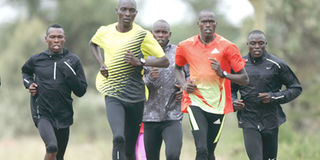Kenyans run up the hills as stars shift up a gear

Photo|MOHAMMED AMIN|NATION
Olympic bound elite athletes from left: Bedan Karoki, Asbel Kiprop, Wilson Kiprop, Nixon Chepseba and Isaiah Kiplangat train at Kimuka in Ngong on July 9, 2012.
Team Kenya stepped up preparation in Nairobi with a section of the athletics team moving their morning training base to Kimuka area in Ngong’.
The session in Kimuka area - where athletes ran from between 45 minutes to one hour and 20 minutes covering a distance of between 10km to one hour and 20 minutes - confirmed their resolve to stick to home training.
The 12 athletes featuring 1,500m to 10,000m men and women hit the terrains from deep inside Kimuka at a place christened “Umbrella” owing to its giant acacia tree canopies shortly past 11am.
The athletes tore through the dusty Kimuka plains before ascending a challenging three-kilometre hill to the summit at Kibiko under the watchful eyes of coaches Julius Kirwa and Peninah Talam, and physiotherapist Daniel Korir.
The journey down the “Umbrella” area could not have ended without some interesting moments.
At one moment, male athletes had to disembark from the ultra modern Athletics Kenya bus to help their driver Samuel Omondi navigate through the gullies with the vehicle’s base almost touching the rocky grounds.
Kasarani sessions
At one time Omondi was spoilt for choice with the varying directives from athletes but it’s coach Kirwa’s humorous commands that came in handy to plough the Korean make bus through.
“Well, those are some of the challenges we go through but it’s inspiring you know,” said Kirwa with a telling laughter.
The 1,500m athletes covered 45 minutes while the women’s 5,000m and both the men and women’s 3,000m steeplechase 55 minutes.
The men’s 5,000m athletes and women’s 10,000m ran for one hour while men’s 10,000m took one hour and 20 minutes.
Besides track sessions at Kasarani, Kirwa said the athletes have alternated training sessions at Kasarani, Karura Forest and Ngong.
Monitoring speed
“We are trying out aerobic and anaerobic variations in view of monitoring the speed and endurance of the athletes.
“Kimuka is a low altitude and hot area, a condition we are likely to face in London while Karura is high with good, fresh air hence both provides good training grounds,” said Kirwa.
Olympic and World 1,500m champion Asbel Kiprop and his metric mile counterpart Nixon Chepseba and the 10,000m team of Wilson Kiprop, Bedan Karoki, Joyce Chepkirui and Sally Kipyego attended the training in Ngong.
Also in the mix were Viola Kibiwott (5,000m) and steeplechase team of Brimin Kipruto, Ezekiel Kemboi, Abel Mutai and Lydia Rotich.
World 800m champion and record holder David Rudisha and Olympic 800m champion Pamela Jelimo were set for Ngong training int he afternoon.
High altitude training
Perhaps United States-based Kipyego is the athlete enjoying the most at altitude. “It’s not a myth or theory since it has been proven that an athlete who trains at altitude will always have an edge over an athlete at sea level,” Kipyego said.
“I have so far adjusted to the altitude and almost at 100 per cent ready.” Kibiwott said she is getting her combination well with Chepseba and Karoki strictly observing their dieting.
“We are not pushing ourselves anymore to avoid burnout,” said Karoki. Kiprop said there was nothing unique in the Ethiopian team picked on Sunday.
“They have the usual culprits but let me affirm that we are not preparing for any team or country,” said Kiprop.
Effects of stitches might have derailed her performance at the recent Paris Diamond League, Lydia Rotich said her body is fine.
“The workout in Karura and Ngong will improve on my speed especially the last 300m.”




